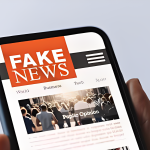Fake news may be described in different ways. It may be a false story cooked up to look real, a non-verifiable or inaccurate piece of information, and manipulated facts created to push particular propaganda. It may even be described as a false narrative that is published and promoted as if it were true.
They may also have humorous aims, as some individuals make use of fake news generators either for the fun of it or to grab attention.
In all, fake news presents misleading information as news and may also span across diverse spheres, as writers of this news take advantage of topics that most people are interested in, such as health, lifestyle, politics, celebrity gist, education, and so on, as their basis for coming up with this news.
With social media and the internet in general, the spread of information has been made very easy. This is because people rely on information to stay enlightened, and so they share whatever gets their attention with family and friends, whether it can be verified or not or whether the sources are legit or not. This, in turn, contributes to the rapid spread of fake news.
So, how do you not fall victim to this? That is what this article is all about. Let us dive in.
Table of Contents
How Do You Spot Fake News?
A lot of things you read online may appear to be true, but they are not. While the rationale behind fake news may be intentional, sometimes sharing it may not be deliberate.
This is why it is important to be able to identify these fake news stories and stop their spread. This means that, in order to avoid sharing fake news, you should be able to spot it. Here are ways to spot fake news:
-
Check if the source and author are verified
If a particular source or author is known for pushing controversies, diverse propaganda, or even humour, you may want to hold on before running with whatever news you get from them.
This is because, according to research, someone who lacks credibility would most likely spread false information in order to influence diverse opinions, gain attention, or make money.
But if they are known for sharing true and verifiable stories, you may trust
It is also vital to check the website URL for things as subtle as spelling errors. Sensationalist headlines should be noted as well
Also, check the sources cited. Are they credible? Are the dates up-to-date and relevant to the news? Taking a close look at these things would provide you with some level of information as regards the credibility of the news.
Talking about verified sources, Subscribe to our Youtube Channel to get Unadulterated information about Tech, Business, Lifestyle and others.
-
Check other sources
This is to confirm if the story is in other places or was found only on one particular site. True and verifiable stories are usually found on other blogs, websites, or pages that one can verify.
This means that you should not rely on a story obtained from just one source. Gathering information from different sources would contribute to getting credible news.
Thus, if that story cannot be seen in any other place, it is most likely a fake one.
-
Look beyond the headline
The authenticity of these stories can be confirmed by the body of the information. So, it is important to look through everything, from the headline to the body, to see if they tally.
This is because some of these headlines are purposely written the way they are to grab attention and spur immediate action that involves sharing. Then, in the long run, the story is saying something else that doesn’t correlate with the headline and even contains a mixture of true stories with fake ones.
For example, fake news can have headlines like:
“CBN approves sharing of money with Nigerians ahead of the elections.”
“Coronavirus cure: it’s in your backyard.”
“Become a billionaire with these simple tricks.”
Surely, headlines like this may make you give a *bombastic side-eye. When a particular headline makes you raise your eyebrow or places a lot of questions that the content isn’t answering in your head, you should check it.
As a result of this, the headline alone shouldn’t make you share. Look through the body very well.
-
Take a careful look at the story
While it is usually hard to confirm the credibility of most stories, a careful look at the story would help verify it to some extent.
No one is above mistakes, but some errors are fishy. Credible stories are constructed in proper sentences by professional writers and editors who do enough research, get their facts right, and have enough evidence before pushing out a story. No professional news organization lets just anyone upload news.
Fake stories, on the other hand, usually have vague facts, low-resolution pictures, and a lot of errors while intentionally leaving some information out. So, when you see a consistent pattern of these things, it is most likely fake news
Effects of Fake News
Real news seeks to inform people, while fake news seeks to confuse and influence people, their opinions, and their decisions.
The composition and sharing of fake news directly or indirectly impact individuals, their finances, relationships, organizations, and society at large.
Some of the consequences of fake news are as follows:
-
Mistrust and scepticism
Fake news results in reduced trust in the media. When people have been fed wrong information over a period of time, they may start to have trust issues, thereby doubting the credibility of whatever piece of information they come in contact with.
It may then make them sceptical about believing any news they come in contact with, which may cause a doubtful and lackadaisical attitude even toward news they should pay attention to.
-
Social conflicts
Not all the information you agree with is real. Thus, conflicting or contradictory viewpoints about a particular subject may cause discord among individuals. This is due to the fact that not everyone will agree with a certain point of view, leading to conflicts and arguments.
Different views and opinions on a certain topic may also be the cause of confusion and disagreements. This can create confusion and misunderstanding about important social and political issues.
For example, political parties may share fake news about their opponents, resulting in divisions and conflicts.
-
Wrong decisions
Information that is circulating has a certain form of influence on individuals, and when this information is not credible, it may fuel the wrong decisions. When false, misleading, or deceptive information forms the basis used to make a decision or take action, wrong decisions are bound to be made.
For instance, when individuals are misinformed on issues pertaining to health, they tend to make wrong decisions based on what they’ve heard. There are many fake and misleading news stories related to medical treatments and major diseases like cancer or diabetes. Trusting these false stories could lead you to make decisions that may be harmful to your health.
Conclusion
As stated earlier, fake news relies on individuals reposting or sharing false information. So, if you are not sure about the authenticity of a piece of information, hopefully, with this article, you will be able to understand what fake news is about, identify it when you see it, and do the needful.
If you would like to be in a community where you can verify information on the digital marketing world, Then Join our WhatsApp community to have access to this verified information.
You can read these recommended articles to stay clear of anything fake.
- How to Identify and Call Out Fake Bank Alert: Protect Your Business From Fraudulent Activity
- How to Spot a Fake Friend in Nigeria
- 9 VALID WAYS TO IDENTIFY A FAKE JOB
Edited by Emmanuel Odebiyi
About Author
- I am a student of Obafemi Awolowo University. A Gen-Z and advocate for the Soft Life. I spend most of my leisure time as a freelancer, creatively curating content and telling relatable stories. I am also passionate about quality lifestyle.
Latest entries
 SpiceDecember 11, 20237 Board Games Among Nigerians That Will Never Get Old
SpiceDecember 11, 20237 Board Games Among Nigerians That Will Never Get Old SpiceNovember 30, 2023How to Spot Fake News and Its Effect
SpiceNovember 30, 2023How to Spot Fake News and Its Effect LifestyleOctober 16, 2023Markets in Lagos and What You Need to Know About Them
LifestyleOctober 16, 2023Markets in Lagos and What You Need to Know About Them LifestyleSeptember 8, 20239 Must-visit Travel Destinations in Nigeria
LifestyleSeptember 8, 20239 Must-visit Travel Destinations in Nigeria

